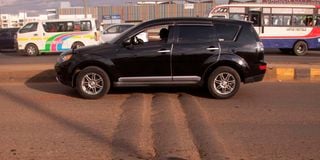Premium
Speed bumps: Mountains of tar and bitumen that became a silent killer

A car slows to a halt on a section of the Thika Super Highway.
What you need to know:
- The Kenyan speed bump is a legendary mountain of bitumen and tar that pops up when you least expect it; a silent assassin waiting quietly round a corner, up a hill, down a valley, on a beautiful straight stretch… everywhere.
- While Kenha is famed for building great national trunk roads, it also takes the heat for ruining its engineering with bumps, ostensibly to control speed and, by extension, reduce accidents.
December 11, 2016: A truck laden with highly flammable cargo is heading to Uganda from Kenya when it hits newly erected speed bumps at the foot of a steep descent just before Naivasha.
The impact throws it in the air before it crashes onto several cars that have lined up to clear the bumps. It explodes, killing 40 at the scene, including passengers in private cars and police officers heading for assignment in a heavy-duty truck. Also killed are fisher folk who have been hawking their day’s catch next to the bumps to motorists, taking advantage of a traffic jam that has built up on both sides of the road as a result of the bumps.
August 24, 2017: Mike Mbuvi Sonko, newly elected governor of Nairobi, threatens to send city council workers to Thika Road to remove a series of bumps and rumble strips that have been blamed for causing day-long gridlocks on both sides of the highway. His threats are supported by thousands of people who use the highway every day, and who wonder why a road designated as a superhighway would be so heavily “bumped”.
A few days later, the Kenya National Highways Authority (Kenha) announces that it will remove the bumps and replace them with pedestrian footbridges, and a few weeks later the agency lives up to its word and clears speed bumps from the Survey and Ruaraka sections of the road.
The Kenyan speed bump is a legendary mountain of bitumen and tar that pops up when you least expect it; a silent assassin waiting quietly round a corner, up a hill, down a valley, on a beautiful straight stretch… everywhere. While Kenha is famed for building great national trunk roads, it also takes the heat for ruining its engineering with bumps, ostensibly to control speed and, by extension, reduce accidents.
But how much is too much? And do road contractors and their supervising engineers at Kenha follow any guidelines on the location, height, sharpness or interval distance when erecting these speed control tools?
Take the newly built road from the town curiously named Kenol to Nyeri, for instance. While the engineers have done a brilliant job designing a modern thoroughfare, they have erected —and still are erecting—tens of speed bumps, causing snarl-ups and fender-benders on busy days all the way from Kenol through Sagana, up the Kangocho hill just before Karatina, and at the junction to Tumutumu. Ditto the previously smooth drive from Thika to Matuu, which now spots bumps near small townships, next to fuel stations, at bends, and generally all over the place.
Mr Victor Bwire, writing for the Media Council of Kenya in January last year, called these road monstrosities “killers in the name of speed bumps”. His anger and choice of words had been caused by what he said were irregularly designed bumps on the road from Busia to Kisumu that had caused the maiming of two youngsters after an accident. And he noted that such badly designed bumps are on every major highway in the country, sometimes even erected by locals using soil reinforced with stones and boulders.
Motorists have also questioned the varying designs of the bumps and rumble strips. It appears there is no standardisation on, for instance, how high a bump should be on a highway. Too low and it serves no purpose, too high, as most of them are, and it becomes a nuisance at low speeds and a veritable killer at highway speeds.
Indeed, examples abound across the country of motorists who say they lost control of their vehicles after they hit huge, unmarked bumps on highways.
Make no mistake, however.
Road bumps have been found useful at controlling speed, especially in residential zones, drastically cutting accidents. Studies have shown that, while they might have other negative results— including noise pollution due to hard acceleration after the bumps and damage by heavy trucks—the benefits outweigh the grievances, especially in built up areas.
There are several types of these speed control devices, and it is not clear what Kenha prefers because of their haphazard deployment.
Road bumps are the most common on Kenyan roads, with their characteristic round-topped construction. On highways, however, drivers prefer speed tables, which are designed to have a central plateau that is both long and broad. This design has worked perfectly well on the stretch of the road from Nakuru to Eldoret.
The other common type of speed control devices are rumble strips, but many countries now prefer to deploy them in rural areas because of the noise they generate as cars run over them at speed. In Kenya, these strips are often badly designed and scarcely allow drivers to run over them at speed without damaging the vehicle’s suspension.





